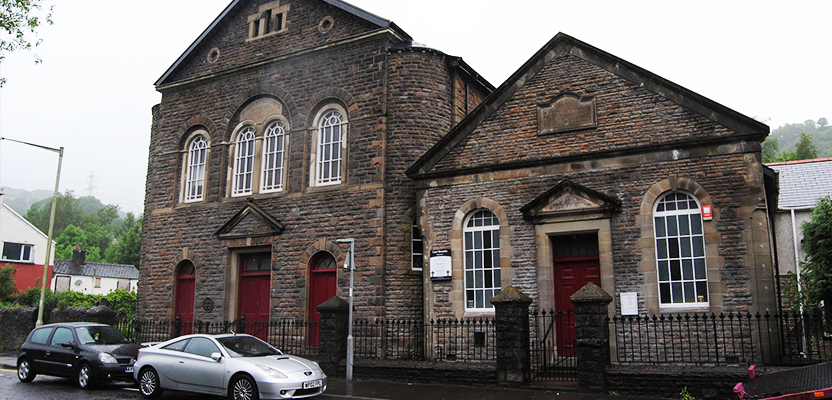Find out more about The Open University’s music courses.
A small number of hymns are so familiar to many Welsh people that it might be tempting to say, for example, that ‘everyone knows ‘Bread of Heaven’’. However, examination of the textual and musical histories of many of the best-known Welsh hymns often reveals complicated stories that can be difficult to untangle. This article takes ‘Bread of Heaven’ (often known by its tune name, ‘Cwm Rhondda’, or the first line, ‘Guide me, O thou great Jehovah’) to highlight some of these historical issues.
Beloved of rugby supporters, ‘Guide me, O thou great Jehovah’ is an English translation of a hymn by the most famous of all Welsh hymn-writers, William Williams, Pantycelyn (1717-91), ‘Arglwydd, arwain trwy’r anialwch’. The original Welsh text was first published in 1762. The first English translation was made by Peter Williams and published in 1771. The famous ‘Cwm Rhondda’ tune, with its stirring climax, was composed by John Hughes (1873-1932), who worked initially as a coal miner and later as a railway clerk. The precise date of the tune is unclear; the first known use of it was in 1907 in Hopkinstown, near Pontypridd.
 Capel Rhondda, Hopkinstown where John Hughes first performed his ‘Cwm Rhondda’ tune in 1907. Photo by The National Churches Trust.
Capel Rhondda, Hopkinstown where John Hughes first performed his ‘Cwm Rhondda’ tune in 1907. Photo by The National Churches Trust.
Two important complicating factors emerge here: the role of translation and the gap of well over a century between the writing of the words and the composition of the tune now inseparable from them. William Williams’ hymns were a staple of Welsh-language Christian worship right through the intervening period, while the Peter Williams’ translation of this hymn was included in many English language hymnals in Wales and beyond. Among Welsh-speaking congregations, a range of tunes have been associated with ‘Arglwydd, arwain trwy’r anialwch’; Alan Luff argues that the minor key tonality of several of them responds to the origins of the text in a period of considerable turmoil within early Welsh Methodism. Similarly, a range of tunes, most now forgotten, were also paired with the English translation.
Two important complicating factors emerge here: the role of translation and the gap of well over a century between the writing of the words and the composition of the tune now inseparable from them.The first known pairing of Hughes’ tune with the English text was in an issue of The Musical Salvationist (a Salvation Army publication) in 1920. This combination soon found its way into denominational hymnals, such as The Methodist Hymn Book (1933). Despite this, William Williams’ original Welsh text has not become similarly strongly associated with the tune. Instead, a hymn text by another famous Welsh hymn-writer, Ann Griffiths (1776-1805), ‘Wele’n sefyll wrth y myrtwydd’ has often been printed with it.
A further complicated aspect of this hymn’s history concerns the melodic pattern of the penultimate phrase in Hughes’ tune (set to the words ‘feed me now and evermore’ in the first verse of the English translation). For much of the twentieth century, two versions were widely published in hymn books: one with the melody staying on the high note throughout above a descending tenor line that then leaps back up to the high note, while the other reverses these parts, with the tenors maintaining the high note while the melody descends. The hymnologist Joseph Herl traced the earliest known publication of the melody, which used the first version; the veracity of this version was confirmed by a score of the tune in tonic sol-fa notation signed by the composer, which is reproduced in A History of Welsh Music.
An interesting more recent trend has been to set Welsh and English words to ‘Cwm Rhondda’ in the same performance, as heard on Bryn Terfel’s We’ll Keep A Welcome: The Welsh Album (1999). Here, Welsh verses from Ann Griffiths and William Williams are inserted between two verses of the well-known English translation. While this would make little sense in the context of a religious service, where the narrative flow of the text is important, it nonetheless testifies to the popularity of ‘Cwm Rhondda’ and the way in which it has become regarded as the quintessential example of the Welsh hymn tune.
Thanks in no small part to it being sung fervently by generations of Welsh rugby supporters, ‘Bread of Heaven’ will be the first example that springs to mind for many people when they think of traditional Welsh hymns. The pairing of words and music is, however, little more than a hundred years old, while the original Welsh-language hymn has enjoyed a markedly different musical history. The relationships between texts and tunes are often complicated in the history of hymns, and this is even more the case when textual translation is added to the picture. Perhaps even more important is the role of practice when investigating the history of hymns. Though the publication history of words and music is important, hymn-singing is also a strongly oral tradition, which means that it is unsurprising that slightly different versions of tunes and texts often co-exist. It is, though, this coming together of words and music in the collective action of singing, whether to affirm religious belief or to celebrate the scoring of a try, that ultimately accords hymns such as this their status.


Rate and Review
Rate this article
Review this article
Log into OpenLearn to leave reviews and join in the conversation.
Article reviews